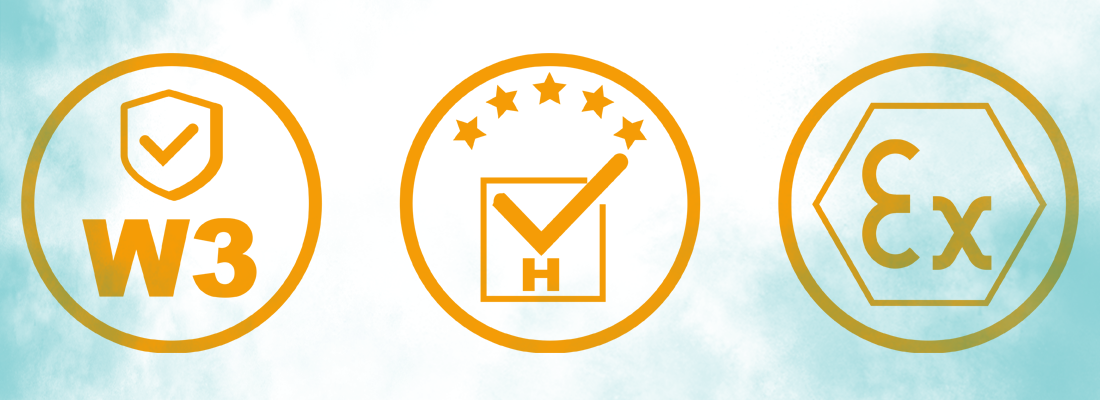Standards and guidelines
Which directives/guidelines do the systems comply?
In order to be able to assess the hazard potential, the RL 2014/34/EU and TRBS 2152 categorize hazardous areas correctly. Labels ensure that products in potentially explosive atmospheres are conform to the conditions for a safe workplace. Equipment and components cannot contain any material, which could cause explosions or release contaminants directly into the environment. Release or processing of individual particles can trigger a dangerous reaction. DIN EN 1127-1:2011-10 defines suitable planning and production measures to achieve the required safety.
The RL2006/42/EC and DIN EN 60204: 2010-05 define appropriate measures to protect the workers from electric shock by electrically powered devices. In this context, DIN EN 61340-5-1 specifies the basic requirements for handling ESD. Depending on the work environment, e.g. the work shoes have to be antistatic with a heat or cold resistant sole. The legal examinations prescribed by law for repeat tests for measuring and control devices in laboratories are carried out after repair and modifications according to DIN VDE 0701-0702 with rated voltages up to AC voltage 1000V/DC voltage 1500V.
The directive 2008/50/EC addresses air quality with regard to health. Clean air is essential at work. For this reason, certain measures ensure the reduction of emissions. Any output is to eliminate directly at the blowout point. The DIN EN ISO 16890 “Air filters for general room air technology” summarizes important characteristics of air filters. Testing and classification procedures enable a suitable filter selection according to the desired separation efficiency. In welding and related processes, DIN EN ISO 15012 describes a method for testing equipment for detecting and separating welding fumes.
The EU Chemicals Regulation (EC) No.1272/2008 (CLP) regulates the classification, labeling and packing of substances or mixtures that may be dangerous to people or the environment. After the risk assessment according to §6 the necessary protective measures have to be taken.
Occupational Exposure Limits (TRGS 900) show the time-weighted average concentration of a substance in the workplace. The limit value indicates the concentration at which harmful effects of a substance are to be expected.
Do you have any further questions?
Please call us at +49 (0) 7082/9473-0 or send us an e-mail to info@tbh.eu.
The RL2006/42/EC and DIN EN 60204: 2010-05 define appropriate measures to protect the workers from electric shock by electrically powered devices. In this context, DIN EN 61340-5-1 specifies the basic requirements for handling ESD. Depending on the work environment, e.g. the work shoes have to be antistatic with a heat or cold resistant sole. The legal examinations prescribed by law for repeat tests for measuring and control devices in laboratories are carried out after repair and modifications according to DIN VDE 0701-0702 with rated voltages up to AC voltage 1000V/DC voltage 1500V.
What ist the best protection against electric shock caused by a powered device?
The DIN EN 60335-2-69 is used for safety of electrical devices for domestic use and similar purposes. It is also valid for special requirements for power and water vacuum cleaners for commercial use. In particular, the insulation is an essential factor, because electric shocks are extremely dangerous and can cause serious damage. Therefore, this is necessary to prevent.The directive 2008/50/EC addresses air quality with regard to health. Clean air is essential at work. For this reason, certain measures ensure the reduction of emissions. Any output is to eliminate directly at the blowout point. The DIN EN ISO 16890 “Air filters for general room air technology” summarizes important characteristics of air filters. Testing and classification procedures enable a suitable filter selection according to the desired separation efficiency. In welding and related processes, DIN EN ISO 15012 describes a method for testing equipment for detecting and separating welding fumes.
Good air quality at the workplace is necessary
EN 1822-1: 2009 defines filtration performance of high-performance particulate filters (EPA); particulate matter filters (HEPA) and high-performance particulate matter filters (ULPA). The standard is the basis for, among other things, the identification and testing of the filter medium.The EU Chemicals Regulation (EC) No.1272/2008 (CLP) regulates the classification, labeling and packing of substances or mixtures that may be dangerous to people or the environment. After the risk assessment according to §6 the necessary protective measures have to be taken.
Occupational Exposure Limits (TRGS 900) show the time-weighted average concentration of a substance in the workplace. The limit value indicates the concentration at which harmful effects of a substance are to be expected.
Do you have any further questions?
Please call us at +49 (0) 7082/9473-0 or send us an e-mail to info@tbh.eu.

